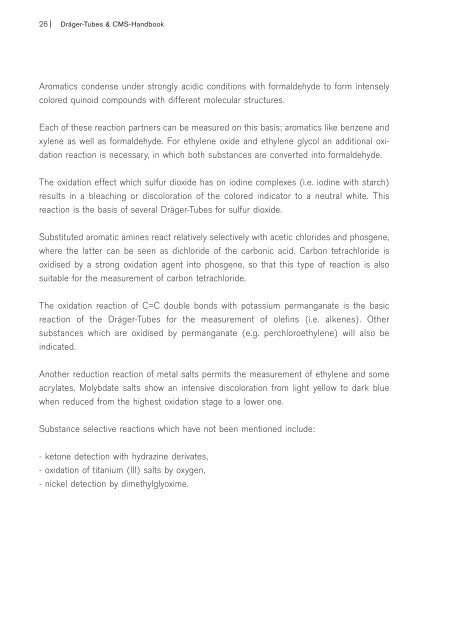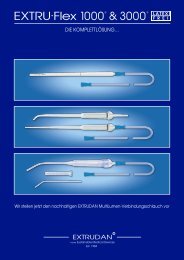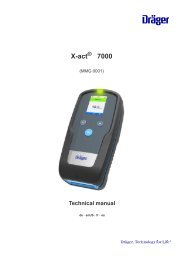Create successful ePaper yourself
Turn your PDF publications into a flip-book with our unique Google optimized e-Paper software.
26| Dräger-<strong>Tubes</strong> & CMS-<strong>Handbook</strong><br />
Aromatics condense under strongly acidic conditions with formaldehyde to form intensely<br />
colored quinoid compounds with different molecular structures.<br />
Each of these reaction partners can be measured on this basis; aromatics like benzene and<br />
xylene as well as formaldehyde. For ethylene oxide and ethylene glycol an additional oxidation<br />
reaction is necessary, in which both substances are converted into formaldehyde.<br />
The oxidation effect which sulfur dioxide has on iodine complexes (i.e. iodine with starch)<br />
results in a bleaching or discoloration of the colored indicator to a neutral white. This<br />
reaction is the basis of several Dräger-<strong>Tubes</strong> for sulfur dioxide.<br />
Substituted aromatic amines react relatively selectively with acetic chlorides and phosgene,<br />
where the latter can be seen as dichloride of the carbonic acid. Carbon tetrachloride is<br />
oxidised by a strong oxidation agent into phosgene, so that this type of reaction is also<br />
suitable for the measurement of carbon tetrachloride.<br />
The oxidation reaction of C=C double bonds with potassium permanganate is the basic<br />
reaction of the Dräger-<strong>Tubes</strong> for the measurement of olefins (i.e. alkenes). Other<br />
substances which are oxidised by permanganate (e.g. perchloroethylene) will also be<br />
indicated.<br />
Another reduction reaction of metal salts permits the measurement of ethylene and some<br />
acrylates. Molybdate salts show an intensive discoloration from light yellow to dark blue<br />
when reduced from the highest oxidation stage to a lower one.<br />
Substance selective reactions which have not been mentioned include:<br />
- ketone detection with hydrazine derivates,<br />
- oxidation of titanium (III) salts by oxygen,<br />
- nickel detection by dimethylglyoxime.


















